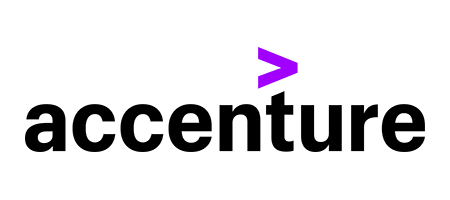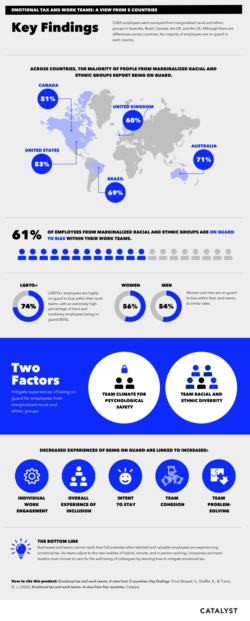Emotional Tax and Work Teams: A View from 5 Countries
Sheila Brassel, PhD , Emily Shaffer, PhD , Dnika J. Travis, PhD
Summary
This report, based on a survey of over 3,000 employees in five countries, reveals that experiences of emotional tax—specifically, being on guard to protect against bias due to race, ethnicity, and gender—are pervasive in Australia, Brazil, Canada, the United Kingdom, and the United States, with 61% of employees from marginalized racial and ethnic groups indicating that they are on guard to bias and discrimination on their teams. With tensions related to race and ethnicity underlying many of today’s current events, organizations need to better understand and address how employees from marginalized racial and ethnic groups experience their team environments and workplaces more broadly. Our data show that a team climate for psychological safety and racial and ethnic diversity on teams can mitigate employees being on guard and boost well-being, inclusion, and engagement at work—as well as team problem-solving and team cohesion. Diverse, hybrid teams are the future of work. Executives, team leaders, and individuals can take action to nurture inclusive team environments by building bridges, showing up, and holding themselves accountable for making change.
The Costs of Emotional Tax
Companies count on high-performing teams to drive innovation and growth, solve business problems, and spark employee engagement. And success skyrockets when teams cultivate an inclusive environment where diversity is valued.1
Yet our data show that a majority of employees from marginalized racial and ethnic groups in Australia, Brazil, Canada, the United Kingdom, and the United States experience emotional tax on their work teams and are on guard to protect against bias due to race, ethnicity, and gender. These experiences are costly for individuals, teams, and their organizations.
Key Findings
- 61% of 3,065 employees from marginalized racial and ethnic groups in Australia, Brazil, Canada, the UK, and the US are on guard to bias within their work teams. Although there are differences across countries, the majority of employees from marginalized racial and ethnic groups are on guard in each country.
- LGBTQ+ employees from marginalized racial and ethnic groups are highly on guard to bias within their work teams (74%), with an extremely high percentage of trans and nonbinary employees being on guard (85%).
- Women (56%) and men (54%) from marginalized racial and ethnic groups are on guard to bias within their work teams at similar rates.
- Two factors mitigate experiences of being on guard for employees from marginalized racial and ethnic groups: team climate for psychological safety and team racial and ethnic diversity.
- Decreased experiences of being on guard are linked to increased:
- Individual work engagement, overall experience of inclusion, and intent to stay.
- Team cohesion and team problem-solving.
The bottom line: Businesses and teams cannot reach their full potential when talented and valuable employees are experiencing emotional tax. As teams adjust to the new realities of hybrid, remote, and in-person working, companies and team leaders must choose to care for the well-being of colleagues by learning how to mitigate emotional tax.
“If you look at the overall organization, and my work environment, there’s not [a sense that the diversity I bring is a] value-add. I feel more like [the message is] ‘be grateful you’re here.’”
— Denise, Black woman, United States2

State of Being On Guard: A Hallmark of Emotional Tax
This experience of being on guard is a hallmark of the emotional tax that employees from marginalized racial and ethnic groups pay in the workplace. Emotional tax is the combination of being on guard against bias because of race, ethnicity, and gender and the associated effects on well-being and ability to thrive at work.4
A Majority of Employees From Marginalized Racial and Ethnic Groups Are On Guard to Bias
We examined the experience of being on guard among employees from marginalized racial or ethnic groups in Australia, Brazil, Canada, the United Kingdom, and the United States. In each of these five countries, we found that most employees report being on guard to bias on their work teams. While the root causes of the differences among countries require more study, these results show that the experience of being on guard is not unique to any single country or racial or ethnic group.
Across countries, people from marginalized racial and ethnic groups report being “on guard.”

LGBTQ+ Employees From Marginalized Racial and Ethnic Groups Are Highly On Guard
Of this group, 62% say they are specifically on guard to bias against their gender, 71% are on guard to bias against their sexual orientation, and 70% are on guard to bias against their race or ethnicity.
These results highlight the diversity within LGBTQ+ employees, and how gender, race or ethnicity, and sexual orientation intersect to shape experiences of being on guard. Indeed, experiences of bias and discrimination compound for employees with multiple marginalized identities,5 for whom multiple forms of oppression are “most often experienced simultaneously… [such as] racial-sexual oppression which is neither solely racial nor solely sexual.”6
As these data reveal with stark clarity, it is absolutely essential that organizations attend to their employees’ experiences with bias and discrimination through an intersectional lens.
“I face stigma and bias every day at work because I am African American and transgender. I have been at work events where a co-worker mocked [a celebrity] because of her transition… Once the co-worker found out I am transgender, they never apologized for the remarks… I am ostracized every day, and cannot wait to leave in a month. I found a more accepting place to work.”
— Daniel, African American transgender man, Canada7
Organizations Must Do Better
Our findings show that across countries, being on guard to bias within your work team is the norm for employees from marginalized racial and ethnic groups. Employees brace for insults, change the way they look, and avoid certain places or social situations to protect against potential bias or being stereotyped on their work teams.8
If employees from marginalized racial and ethnic groups can’t be fully seen by their teammates—or worse, brace for bias and discrimination from them—where can they thrive at work?
Organizations can start making change by constructing teams that are more diverse and by fostering an inclusive workplace climate where people can have real conversations about the obstacles they face.
Employees—and Teams—Thrive When People Are Less On Guard
Across countries, when employees from marginalized racial and ethnic groups are less on guard, they are:
4x more likely to:
- Experience inclusion—being valued, trusted, authentic, and psychologically safe at work.13
Two Factors Make a Difference
Our data point to two crucial factors that are at the core of a team environment where employees from marginalized racial and ethnic groups are less on guard to bias:14
- Team climate for psychological safety
- Team racial and ethnic diversity
Team Climate for Psychological Safety
On the flip side, teams that cultivate a climate for psychological safety:
- Recognize the value of being honest and realistic about workplace difficulties rather than hiding them.
- Encourage problems to be brought to the surface. For example, by asking “What am I missing?” team leaders can carve out space for team members to name simmering issues, which ultimately aids in problem-solving.16
- Build awareness that ignoring or downplaying tough issues only causes the issues to grow.
- Normalize that team members are not defined by the concerns they raise, problems they name, or mistakes they’ve made.
- Recognize that addressing tough workplace issues head-on without undue penalty can drive innovation.
Our findings show that employees from marginalized racial and ethnic groups are less on guard when they experience a team climate for psychological safety, which also opens the door for better team problem-solving and innovation.17
The importance of team climate for psychological safety in relation to being less on guard dovetails with extensive research that documents the ways employees from marginalized racial and ethnic groups are faced with an “overwhelming pressure to be perfect” at work,18 including being punished more harshly than White employees for any misstep19 and risking any errors being tied to their racial group.20
For these employees, the pressure to be perfect exacts a high cost. Our results revealed that one antidote is to create a team environment where it is safe to be honest about obstacles and problems, lessening the risk of being treated differently or being targeted with bias if employees from marginalized racial or ethnic groups raise a tough issue.
Team Climate for Psychological Safety
Team members can address tough workplace issues without undue penalties or repercussions.
“I called [out] sick one day and my manager… asked, ‘Why are you taking sick leave? You need to leave the job or go part-time or be casual.’ But [in] the same case to my Aussie friend… instead he asked, ‘How are you feeling today?’ I was expecting the same question for me.”
— David, Indian man, Australia21
Team Racial and Ethnic Diversity
Our findings indicate that team racial and ethnic diversity is also critical for being less on guard on work teams. In other words, the more racially and ethnically diverse a team is, the less likely team members from marginalized racial and ethnic groups will be on guard.
Research points to the perils of “tokenism” or being one of only a few employees from a marginalized group in an organization or team—whether because of race, ethnicity, nationality, religion, gender, age, ability, sexual orientation, or another identity.22 For example, researchers have found that employees who are tokens at work because of their race or ethnicity have elevated levels of multiple forms of stress, including loss of identity, feelings of isolation, need to overperform, and pressure to speak on behalf of the group they belong to.23
In addition to the potential to alleviate these stressors, a diverse work environment has been shown to have other payoffs, including fewer reported experiences of discrimination and microaggressions.24
“People in my workplace were mostly White so none of them wanted to be friends with me or hang out with me because I was a person of colour. They discriminated [against] me and always called me names and I always felt like I didn’t belong. They would make stereotypes about me, that I smell and that my accent is funny.”
— Anita, Pakistani woman, the United Kingdom25

Starter Steps and Heavy Lifters
We found that for people of all genders, inclusive team norms are helpful for mitigating emotional tax;26 and for women from marginalized racial and ethnic groups specifically, team gender diversity is also connected with being less on guard.27 So, these factors are helpful starter steps.
However, our data reveals that team climate for psychological safety and team racial and ethnic diversity have the largest impact on experiences of being on guard.28 These two factors do the heavy lifting when building a team environment where employees from marginalized racial and ethnic groups are not burdened with being on guard.
How Leaders and Teams Can Create Change
Everyone on a team can play a vital role in mitigating their colleagues’ experiences of emotional tax. Now is the time to do your part to unlock change and create more inclusive, equitable workplaces. Here are key steps that you can take:
Senior leaders and executives:
Be honest with yourself: Do your efforts stop at lip service? Or are you walking the talk? Communicate authentically and proactively to share what you’re learning and your growth edges in town halls and one-on-one meetings with direct reports and other senior leaders.
Build bridges: Enact programs that help employees communicate and understand one another across dimensions of difference. Reach out to make sure people from different cultural, ethnic, and racial backgrounds are valued and their stories are heard.
Reward change: Create policies that hold leaders at all levels of the organization accountable by tying DEI goals to compensation or incentives.
Upskill everyone: Invest in and require participation in inclusive leadership training so that team leaders have the skills and experience to create inclusive team norms. Better yet, require executives to attend as well—including yourself. Leaders at all levels can and should aim to improve their leadership skills.

“In our company, we have [many] transgender employees….We do hard work with our teams, with our people, about acceptance and respect. Respect people from different sexual orientations, from different religions, from different [genders], et cetera. You know, we always said that respect is our word…..When people receive information and understand, they totally change, you know, they say ‘Oh, now I understand.’…Please open the doors to people… I really think that it’s the key, the communication, the information.”
— Noam, Chilean man, Brazil29

Team leaders:
Create a plan: Intentionally build team diversity by investing in or advocating for inclusive recruiting strategies such as reevaluating job qualifications and descriptions, expanding how and where you source talent, mandating diverse candidate slates and interview panels, and more.
Show up: Flex your allyship and curiosity skills. Ask: How can I amplify the voices of people from marginalized communities, ensuring that their ideas, thoughts, and contributions are known and valued in the organization?30 Use your power, influence, expertise, resources, skills, and relationships to advocate for individual and structural change.31 Remember, allyship is not about getting accolades, credit, or personal rewards. Seek to promote the voices and contributions of people from marginalized groups—even if they don’t know you are doing it.32
Make mistakes openly: Aim to create an environment where perfectionism isn’t the norm. Model your commitment by being open and honest about your own mistakes and treating them as growth opportunities. Use inclusive team norms to set up a climate of psychological safety, helping to ease the “overwhelming pressure to be perfect” that employees from marginalized racial and ethnic groups face because of negative beliefs about their race.33
“Sometimes in meetings [my manager would] ask the question, people would jump in, sharing their thoughts….And then after that he’d be like, ‘Do you have something to say?’….He always said ‘[You have] good thoughts, so say them.’ In a positive way, not like telling me to speak. But he encouraged me on multiple occasions and now I’m at that place where I feel very comfortable doing so.”
— Kira, South Asian woman, Canada34
What individual team members can do:
Talk to colleagues: Learn from and with team members through conversation—sharing perspectives, speaking up to challenge the status quo, and being real with one another.
Be compassionate: Be willing to admit your own mistakes; find grace for coworkers to make mistakes and take risks without being penalized. Model the behaviors you would like to receive when you misstep.
Hold yourself accountable: We all make mistakes and can inadvertently say the wrong things even with the best intentions, but it’s essential to own your impact. When you misstep, take responsibility, apologize, and make sure your colleagues know what you have learned and how you plan to do things differently in the future.35
Hold others accountable: Speak up against exclusionary behavior. This might mean saying something in the moment or later.

“Being the only one of a different culture in my workplace, I’m constantly on guard. Particularly when racist jokes come up or talk about [a political event], I’m always on guard. Therefore…I have to take a breather outside, take a break, or just mentally take myself out of the situation and think positive things about my family, my kids, and ignore what I [cannot] change.”
— Sandra, Latina, United States36
About the Authors
Sheila Brassel, PhD, is a mixed-methods, interdisciplinary researcher committed to building more diverse, equitable, and inclusive workplaces. At Catalyst, she contributes expertise in intersectionality, inclusion, sexual harassment, and experiences of bias related to gender, race, and sexual orientation to Catalyst’s global research programs. Sheila uses data-driven insights on these and other DEI topics to provide organizations with actionable solutions for building inclusive workplaces.
Emily Shaffer, PhD, is a social psychologist whose research has focused on reducing disparities in education and career fields that arise from negative stereotypes about women and people from underrepresented racial and ethnic groups. At Catalyst, Emily leads the Inclusive Workplace Cultures research stream and is passionate about using her expertise in stereotyping and prejudice to help create more inclusive and equitable workplaces.
Dnika J. Travis, PhD, is a recognized researcher, change leader, and inclusion strategist focused on partnering with leaders of all levels to build engaged teams and guide inclusive culture transformation. As a sought-after speaker and advisor, Dnika’s research on inclusive leadership, engaging in tough conversations, intersectionality, and emotional tax has fueled content for learning programs and has been featured in top-tier media outlets.
Methodology
About the Emotional Tax Series
This study is the fifth in Catalyst’s emotional tax series, which identifies challenges and solutions to workplace inclusion centered on race, ethnicity, and gender. For this report, we draw on global survey data collected through the Catalyst Inclusion Accelerator, a diagnostic tool that measures and monitors drivers, indicators, and outcomes of inclusion at work.
Four prior reports detail the day-to-day experiences people from marginalized racial and ethnic groups have of being on guard to bias, in and outside the workplace, and the associated effects on individual and workplace outcomes such as sleep, inclusion, psychological safety, and employee retention.
The reports have been frequently cited in top-tier media37 and used by business leaders to create more equitable and inclusive workplaces.
About This Study
We surveyed 3,065 people from marginalized racial and ethnic groups working in five countries: Australia, Brazil, Canada, the United Kingdom, and the United States.
These countries were selected because of the ability to collect sufficient racial and/or ethnic demographic data from survey respondents. In each of these countries, people from marginalized racial and ethnic groups may have similar, though certainly not identical, experiences in navigating bias, unfair treatment, and discrimination in the workplace and society as a whole.38
Identities such as lesbian, gay, bisexual, transgender, nonbinary, queer, and many others (LGBTQ+) have meaningful distinctions within and across individuals and countries.39 At the same time, LGBTQ+ employees often have similar, though certainly not identical, experiences navigating bias and discrimination within and outside of work.40
We simultaneously recognize, respect, and value the integrity of each unique identity within the LGBTQ+ umbrella; emphasize the importance of providing data on experiences of bias and discrimination that would not otherwise be possible for each distinct identity group due to sample size limitations; and honor the social and cultural significance of broader LGBTQ+ communities.
The intent of this research is to understand the extent to which people from marginalized racial and ethnic groups experience emotional tax in their workplace and investigate mitigating and exacerbating factors. Our aim was not to draw comparisons or conclusions between the experiences of people from marginalized racial and ethnic groups in different countries. Instead, this research sought to take a deeper look into the experiences of people within each country.
Demographics
Coding and Analysis
- Study participants were asked about experiences on and perceptions of their work teams, their experiences of inclusion and being on guard, and their engagement and intent to stay at their current organization. Responses to these questions ranged from 1 (never) to 5 (always).
- When responding to questions about the experience of being on guard within their work teams, participants were asked to reflect on their experiences within the last six months.
- Participants were also asked to provide information about the racial or ethnic diversity on their work teams. Response options were: 1 (everyone, or nearly everyone, on my work team identifies with the same race or ethnicity), 2 (my work team has some racial or ethnic diversity), and 3 (my work team consists of many different races or ethnicities).
- Participants were also asked to provide information about team gender diversity, and response options ranged from 1 (majority men) to 5 (majority women).
- To analyze this data, we conducted correlations, logistic regressions, and hierarchical linear regressions. All results presented in this report were significant at p < .001 unless otherwise noted.
- The overall percentage of employees who are on guard (61%) is weighted by country so as not to disproportionately reflect countries with larger sample sizes in the overall results.
Acknowledgments
We thank our Leading for Equity and Inclusion donors for their generous support of our work in this area.




The Coca-Cola Company
Dell Technologies
KeyBank
Kimberly-Clark Corporation
KKR
KPMG LLP
Raytheon Technologies Corporation
Edward Jones
Pitney Bowes Inc.
How to cite: Brassel, S., Shaffer, E., & Travis, D. J. (2022). Emotional tax and work teams: A view from five countries. Catalyst.
Endnotes
- Brassel, S., Van Bommel, T., & Robotham, K. (2022). Three inclusive team norms that drive success. Catalyst.
- Thorpe-Moscon, J., Pollack, A., & Olu-Lafe, O. (2019, p. 26). Empowering workplaces combat emotional tax for people of colour in Canada. Catalyst.
- Brassel, S., Ohm, J., & Travis, D. J. (2021). Allyship and curiosity drive inclusion for people of color at work. Catalyst.
- Travis, D. J. & Thorpe-Moscon, J. (2018). Day-to-day experiences of emotional tax among women and men of color in the workplace. Catalyst.
- Berdahl & Moore (2006).
- Combahee River Collective. (1995, p. 235). Combahee River Collective statement. In B. Guy-Sheftall (Ed.), Words of fire: An anthology of African American feminist thought (p. 232-240). New Press. (Original work published 1977).
- Travis & Thorpe-Moscon (2018, p. 14).
- Gyimah, M., Azad, Z., Begum, S., Kapoor, A., Ville, L., Henderson, A., & Dey, M. (2022). Broken ladders: The myth of meritocracy for women of colour in the workplace. The Fawcett Society.
- A logistic regression was conducted to examine how being on guard shapes intentions to stay in one’s organization. In order to understand the benefits of being less on guard for intentions to stay, we reverse-scored frequency of being on guard such that 1 = has not been on guard in their work team in the last six months, 0 = has been on guard in their work team in the last six months. Age, rank, sexual orientation, gender, and country of work were included as covariates. The logistic regression was statistically significant: X2 (10) = 184.19, p < .001, Nagelkerke R Square = 0.09. When employees are not on guard to bias in their work teams, they are nearly 3x more likely to report intend to stay in their organization, b = .98, Exp(B) = 2.68, p < .001.
- A logistic regression was conducted to examine how being on guard shapes experiences of employee engagement. In order to understand the benefits of being less on guard for employee engagement, we reverse-scored frequency of being on guard such that 1 = has not been on guard in their work team in the last six months, 0 = has been on guard in their work team in the last six months. Age, rank, sexual orientation, gender, and country of work were included as covariates. The logistic regression was statistically significant: X2 (10) = 288.82, p < .001, Nagelkerke R Square = 0.14. When employees are not on guard to bias in their work teams, they are nearly 3x more likely to report high levels of engagement, b = .99, Exp(B) = 2.69, p < .001.
- A logistic regression was conducted to examine how being on guard shapes experiences of team cohesion. In order to understand the benefits of being less on guard for team cohesion, we reverse-scored frequency of being on guard such that 1 = has not been on guard in their work team in the last six months, 0 = has been on guard in their work team in the last six months. Age, rank, sexual orientation, gender, and country of work were included as covariates. The logistic regression was statistically significant: X2 (10) = 263.94, p < .001, Nagelkerke R Square = 0.12. When employees are not on guard to bias in their work teams, they are nearly 3x more likely to experience high levels of team cohesion, b = 1.04, Exp(B) = 2.82, p < .001.
- A logistic regression was conducted to examine how being on guard shapes experiences of team problem-solving. In order to understand the benefits of being less on guard for team problem-solving, we reverse-scored frequency of being on guard such that 1 = has not been on guard in their work team in the last six months, 0 = has been on guard in their work team in the last six months. Age, rank, sexual orientation, gender, and country of work were included as covariates. The logistic regression was statistically significant: X2 (10) = 283.92, p < .001, Nagelkerke R Square = 0.13. When employees are not on guard to bias in their work teams, they are nearly 3x more likely to report effective team problem-solving, b = .96, Exp(B) = 2.62, p < .001.
- A logistic regression was conducted to examine how being on guard shapes experiences of inclusion at work. In order to understand the benefits of being less on guard for inclusion, we reverse-scored frequency of being on guard such that 1 = has not been on guard in their work team in the last six months, 0 = has been on guard in their work team in the last six months. Age, rank, sexual orientation, gender, and country of work were included as covariates. The logistic regression was statistically significant: X2 (10) = 403.77, p < .001, Nagelkerke R Square = 0.18. When employees are not on guard to bias in their work teams, they are nearly 4x more likely to report high levels of inclusion, b = 1.37, Exp(B) = 3.95, p < .001.
- To examine the associations between team climate for psychological safety, team racial and ethnic diversity, inclusive team norms, and team gender diversity with being on guard, we conducted a hierarchical linear regression. Participants’ age, rank, sexual orientation, gender, and country of work were entered in Step 1. The Step 1 model was significant, R2 = .250, F(9, 2788) = 103.06, p < .001. At Step 2, inclusive team norms and team gender diversity were entered and the model explained significantly more variance in being on guard: ΔR2 = .045, F(11, 2786) = 105.68, p < .001. In Step 2, inclusive team norms significantly predicted on guard, b = -.22, t(2786) = -13.27, p < .001; however, team gender diversity was not a significant predictor of being on guard, b = -.0004, t(2795) = -.05, p = .960. Finally, at Step 3, team climate for psychological safety and team racial and ethnic diversity were entered and the model explained significantly more variance in being on guard: ΔR2 = .075, F(13, 2784) = 125.64, p < .001. Team climate for psychological safety was a significant predictor of being on guard, b = -.26, t(2784) = -16.44, p < .001; team racial and ethnic diversity was also a significant predictor of being on guard, b = -.11, t(2784) = -6.57, p < .001. However, inclusive team norms became a marginally significant predictor at this step, b = -.05, t(2784) = -2.66, p = .008; team gender diversity remained not significant.
- Burris, E. R., & Sohn, W. (2021). Creating a culture of voice. Behavioral Science & Policy, 7(1), 57-68; McClean, E. J., Martin, S. R., Emich, K. J., & Woodruff, C. T. (2018). The social consequences of voice: An examination of voice type and gender on status and subsequent leader emergence. Academy of Management Journal, 61(5), 1869-1891.
- Correlation between team climate for psychological safety and team problem-solving (n = 3,065), r = .49, p < .001
- Correlation between team climate for psychological safety and team innovation (n = 3,065), r = .39, p < .001. Correlation between team climate for psychological safety and team problem-solving (n = 3,065), r = .49, p < .001
- Osseo-Asare, A., Balasuriya, L., Huot, S. J., Keene, D., Berg, D., Nunez-Smith, M., Genao, I., Latimore, D., & Boatright, D. (2018, p. 7). Minority resident physicians’ views on the role of race/ethnicity in their training experiences in the workplace. JAMA Network Open, 1(5), e182723-e182723.
- Wingfield, A. H., & Wingfield, J. H. (2014). When visibility hurts and helps: How intersections of race and gender shape Black professional men’s experiences with tokenization. Cultural Diversity and Ethnic Minority Psychology, 20(4), 483-490; Rosette, A. S., & Livingston, R. W. (2012). Failure is not an option for Black women: Effects of organizational performance on leaders with single versus dual-subordinate identities. Journal of Experimental Social Psychology, 48(5), 1162–1167.
- Osseo-Asare, et al. (2018).
- World of Voices Research Initiative. (2022). [Unpublished data]. Catalyst.
- Kantor, R. M. (1977). Some effects of proportions on group life: Skewed sex ratios and responses to token women. American Journal of Sociology, 82(5), 965-990; Jackson, P., Thoits, P., & Taylor, H. (1995). Composition of the workplace and psychological well-being: The effects of tokenism on America’s Black elite. Social Forces, 74(2), 543-557.
- Jackson et al. (1995).
- Meyers, C., Aumer, K., Schoniwitz, A., Janicki, C., Pauker, K., Chang, E. C., Gaither, S. E., & Williams, A. (2020). Experiences with microaggressions and discrimination in racially diverse and homogeneously white contexts. Cultural Diversity and Ethnic Minority Psychology, 26(2), 250–259.
- World of Voices Research Initiative. (2022). [Unpublished data]. Catalyst.
- Correlation between inclusive team norms and being on guard (n=3,065), r = -.28, p < .001.
- The correlation between team gender diversity and being on guard varied by respondent gender. For cisgender women, being on a team with more women was significantly correlated with being less on guard [(n = 1,592), r = -.14, p < .001]. However, this correlation was not significant for cisgender men [(n = 1,426), r = .05, p = .07], or trans and nonbinary respondents [(n = 20), r = .04, p = .87].
- See endnote 14 for hierarchical regression analysis results.
- World of Voices Research Initiative. (2021). [Unpublished data]. Catalyst.
- Brassel et al. (2021).
- Brassel et al. (2021).
- Brassel et al. (2021).
- Osseo-Asare et al. (2018, p. 7).
- Thorpe-Moscon et al. (2019, p. 8).
- Brassel et al. (2021).
- Travis & Thorpe-Moscon (2018, p. 6).
- See for example: Edwards, B. (2018, February 15). Women and men of color pay an ‘emotional tax’ at work that’s detrimental to their overall health and ability to thrive: Report. The Root; Reed, A. M. (2021, May 24). The emotional tax of deficit thinking. Stanford Social Innovation Review; Smith, L. (2020, June 13). Why do women of colour pay an ‘emotional tax’ at work. Yahoo!news; Montañez, R. (2019, September 16). How to cope when being a minority at work contributes to stress. Forbes; Tugend, A. (2018, September 30). The effect of intersectionality in the workplace. The New York Times.
- Brassel et al. (2021).
- van Anders, S. (2015). Beyond sexual orientation: Integration gender/sex and diverse sexualities via Sexual Configurations Theory. Archives of Sexual Behavior, 44(5), 1177-1213.
- Cech, E., Montgomery, G., Settles, I., Elliott, K., Cheruvelil, K. S., & Brassel, S. (2021). The social is professional: The effects of team climate on professional outcomes for LGBTQ persons in environmental science. Journal of Women and Minorities in Science and Engineering, 27(5), 25-48; Gates. G. J., & Newport, F. (2012). Special report: 3.4% of US adults identify as LGBT. Gallup.
